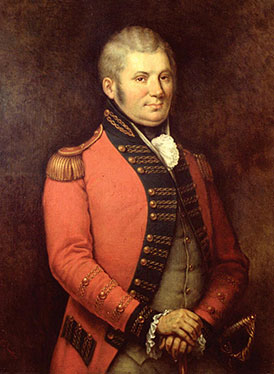
Francis Simcoe
The original Castle Frank was the summer homestead of Upper Canada’s first lieutenant-governor, John Graves Simcoe, named after his son, Francis. Francis Gwillim Simcoe was born on 6 June 1791 near Honiton, Britain, shortly before his father received his commission as lieutenant-governor, and his family set sail to Canada. Francis was the couple’s first son after Elizabeth Simcoe had previously given birth to five daughters.
John, Elizabeth, Francis and two daughters took up residence in York in 1793, where the family lived out of tents.
Construction of Castle Frank
Simcoe wanted a summer cottage north of town. He obtained a concession of 200 acres on the western edge of the Don Valley, south of what is currently Bloor Street. The free grant of the land was registered in the name of his son, Francis.
Elizabeth Simcoe wrote of the property: “We…climbed up an exceedingly steep hill, or rather a series of sugar-loafed hills, and approved of the highest spot, from whence we looked down on the tops of large trees…. There are large pine plains around it, which, being without underwood, I can ride or walk on…."
Simcoe had his soldiers clear a sufficient area to construct a pine log structure. The building, according to the website Toronto Then and Now, was “modelled on the plan of a classical Greek temple. A portico was built on either side of the house, both of which were supported by 16-foot-high pillars made of peeled pine logs. Four windows ran down each side of the house….”
The house had an unobstructed view of the Don Valley. Marble wasn’t available for the pillars, so the builders “used the trunks of four large, well matched, unbarked pine trees,” according to John Ross Robertson, the publisher of Elizabeth Simcoe's diary. The interior was not nearly as refined, consisting of two rooms, each with its own fireplace. The outer walls of the structure were unpainted.
A path was cut through the trees to connect Castle Frank with the town of York. The path was eventually incorporated into what is now Parliament Street in Toronto. An alternative route to Castle Frank in winter was by sled over the frozen Don River. The residence could also be reached by canoe in summer, as the water level in the Don River was much higher in this period.
Castle Frank after the Simcoes
The Simcoe family left Canada in 1796. Francis was five years old at the time. He never again saw the summer home that bore his name. Francis would later be purchased an officer's commission in the British army, and he died in 1812 during an infantry charge in the Siege of Badajoz in Spain.
Castle Frank did not prosper after the Simcoes’ departure.
John Ross Robertson writes in The Diary of Mrs. John Graves Simcoe that ".…after Governor Simcoe’s return to England Castle Frank was occasionally used by President Peter Russell and his family for a picnic, excursion party or ball….” Russell was the interim administrator of Upper Canada before the appointment of the next lieutenant-governor in 1799. Russell later gave permission to Captain John Denison, an officer in the English militia, to stay at Castle Frank during his time at York.
In 1803, Colonel Thomas Talbot visited Castle Frank. He wrote how it was uninhabited and "going to ruin." He also described how it had been vandalized.
During the sacking of York in 1813, American soldiers noticed the name of Castle Frank on a map. Thinking it an actual castle, they paid a visit, only to find a large rotting wood cabin.
In 1829, Castle Frank was being used by what Robertson described as "amateur fishermen" who accidentally burned the cabin to the ground.
Legacy
Descendants of John Graves Simcoe eventually sold off his holdings in Upper Canada. John Scadding purchased a parcel of the Castle Frank land and his son later donated a portion to St. James Cemetery.
Sir Albert Edward Kemp, a Conservative member of Parliament and militia minister during the First World War, built a 24-room manor north of the original site. He named his home Castle Frank in honour of the local history. The house was knocked down in 1962 to make room for a school, now called Rosedale Heights School of the Arts.
Castle Frank subway station, located at Bloor Street East and Castle Frank Road, was opened in 1966. A nearby brook bears the same name.
A historical marker was erected in 1954 in nearby Prince Edward Viaduct Parkette to commemorate the original site of the Castle Frank cabin.


 Share on Facebook
Share on Facebook Share on X
Share on X Share by Email
Share by Email Share on Google Classroom
Share on Google Classroom


